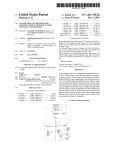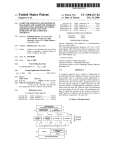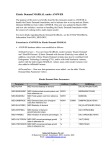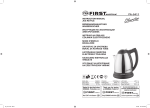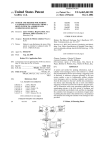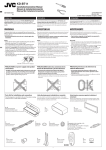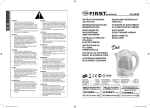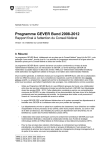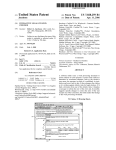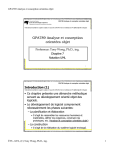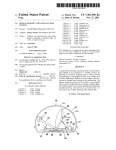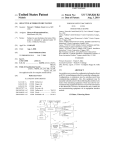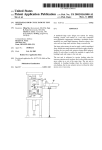Download Three dimensional modeling and animation system using master
Transcript
US007233326B1
(12)
(54)
(75)
United States Patent
(10) Patent N0.:
Silva et al.
(45) Date of Patent:
THREE DIMENSIONAL MODELING AND
5,490,246 A
ANIMATION SYSTEM USING MASTER
OBJECTS AND MODIFIERS
5,583,977 A *
5,689,711 A *
Inventors: Daniel David Silva, San Rafael, CA
_
.
Jun. 19, 2007
2/1996 Brotsky et al.
12/1996 Seidl ........................ .. 345/619
11/1997 BardasZ et a1. ........... .. 717/105
5,731,819 A
3/1998 Gagné et al.
5’745’l22 A
4/1998 Gay. et a1‘
5,796,400 A
(US), Rolf Walter Berteig,
Seattle, WA
.
.
US 7,233,326 B1
5 , 801 , 709 A
8/1998
Atkinson et al.
9/1998 SuZuki.
et al.
(Us); Donald Lee Brutal“, Santa
Barbara, CA (Us); Thomas Dene
5,818,452 A
10/1998 Atkinson et al.
5,838,973 A * 11/1998 Carpenter-Smith et al. . 717/105
Hudson, PO11 washlngton, WI (US);
5,883,638 A *
3/1999 Rouet et a1. .............. .. 345/473
Gary S. Yost, San Francisco, CA (US)
(Continued)
(73) Assignee: Autodesk, Inc., San Rafael, CA (US)
(*)
Notice:
OTHER PUBLICATIONS
Subject? any disclaimeri the term of this
patent is extended or adjusted under 35
David Lau-Kee et al., “VPL: An Active Declarative Visual Pro
gramming System,» IEEE, 1991, pp‘ 4046,
U.S.C. 154(b) by 420 days.
(Continued)
(21) Appl' NO': 10/384’128
(
22
)
(63)
Fld:
1e
Primary ExamineriUlka Chauhan
Assistant ExamineriDaniel Hajnik
M .6 2003
at ’
(74)Att0rney, Agent, or FirmiPatterson & Sheridan, L.L.P.
Related US. Application Data
Continuation of application No. 09/282,590, ?led on
Mar- 31> 1999’ HOW Pat- NO~ 6550339
(57)
ABSTRACT
Athree dimensional (3D) modeling system for generating a
Int‘ Cl‘
a computer system. The modeled object is represented by an
3D representation of a modeled object on a display device of
(51)
G06T 15/00
(200601)
initial de?nition of an object and a set of modi?ers. Each
GMT 17/00
(200601)
modi?er modi?es some portion of the de?nition of an object
(52)
US. Cl. ..................... ..
(58)
Field of Classi?cation Search .............. .. 345/419,
rendered The modi?ers are ordered 50 that the ?rst modi?er
_ 34_5/619, 441, 645, 427, 650, 661; 676, 473
modi?es some portion of the initial de?nition of the object
(56)
345/419; 345/420; 345/619
that may result in a Change in appearance Ofthe Object When
See aPPhCaUOn ?le for Complete Search 11151013’ References Cited
and produces a modi?ed de?nition. The next modi?er modi
?es the results of the previous modi?er. The results of the
last modi?er are then used in rendering processes to generate
the 3D representation. Each modi?er is associated With a
US. PATENT DOCUMENTS
4,985,854 A
1/1991 Wittenburg
5,437,008 A *
7/1995
5,467,443 A
5,483,626 A
three dimensional representation so that the user can more
easily visualize the e?cect of the modi?er.
Gay et a1. ................. .. 715/502
ll/l995 Johnson et al.
8 Claims, 14 Drawing Sheets
1/1996 Nakayama
Derived Tube's Graphical Representation 134
X
Master
Modi?er
Twist
Modi?er
190
192
1 B4
Perspective View 132
‘‘
Tube Modi?er Stack 180
' I '
Scene 142
3D Modeling 8. Animation Application
145
Memory 140
Display Dev/toe
\
3D Modeling &
Animation interface
135
Bus 150
Input Device(s)
120
Computer System 100
Processor
110
US 7,233,326 B1
Page 2
US. PATENT DOCUMENTS
5,936,628 A *
5,982,388 A *
8/1999 Kitamura et a1. ......... .. 345/420
11/1999 Nakagawa ................ .. 345/473
OTHER PUBLICATIONS
3D Studio Max User Manual, vol. 1 and 2 and Tutorial, Kinetix,
Autodesk, 1119-, Mar 1996,1311 l-l4thr9ugh1-15, 6-1t11r9ugh6-l2,
6,128,631
6
A * 10/2000 Wallace
Silva et et a1. ........... .. 715/502
JmnT2?l7F;’1:Zde;215"
through
and
46hgltroducnon
tutorial
tothrough
Computer Graphlcs’ 1994’
6,331,861 Bl*
pp‘
6,424,354 B1 *
12/2001
Gever et a1. .............. .. 345/629
7/2002 Matheny et a1. .......... .. 345/619
* cited by examiner
'
U.S. Patent
Jun. 19, 2007
Sheet 2 0f 14
US 7,233,326 B1
Application
Controi
200
1
Derived Object
Representation
246
P'Xe! Data
256
Derived
Object
270
Rendering Pipeline
250
.
Display Buffer
A
260
Object
Space
Modi?er
220
Figure 2
Modi?er Stack
280
k
U.S. Patent
Jun. 19, 2007
Sheet 12 0f 14
US 7,233,326 B1
e
Q22E
2
k
k
2
h
L
82325m 3:62 am
568cm;
omm
.850 83m 5 82 RN
6$5%82 8m
U.S. Patent
Jun. 19, 2007
Sheet 13 0f 14
US 7,233,326 B1
YES-T
No
Cache Final
Channel Values
4
1360
Determine Modi?ed
Channel Values
1320
<—NO
Y
Start
odi?ed Channel Values
Stable for X Frames?
1330
YBS
ext Element Changes
Modi?ed Channel Values in
Next Frame?
1340
YES
i
Cache Modi?ed
Channel Values
1350
Figure 13
US 7,233,326 B1
1
2
THREE DIMENSIONAL MODELING AND
ANIMATION SYSTEM USING MASTER
OBJECTS AND MODIFIERS
SUMMARY OF THE INVENTION
One embodiment of the invention includes a method of
generating a three dimensional (3D) representation of a
modeled object on a display device of a computer system.
The modeled object is represented by an initial de?nition of
RELATED APPLICATIONS
an object and a set of modi?ers. Each modi?er modi?es
some portion of the de?nition of an object that may result in
This application is a continuation of US. patent applica
tion Ser. No. 09/282,590, entitled “Three Dimensional Mod
eling and Animation System”, ?led Mar. 31, 1999, now US.
Pat. No. 6,650,339 by inventors Daniel David Silva, Rolf
Walter Berteig, Donald Lee Brittain, Thomas Dene Hudson,
a change in appearance of the object When rendered. The
modi?ers are ordered so that the ?rst modi?er modi?es some
portion of the initial de?nition of the object and produces a
modi?ed de?nition. The next modi?er modi?es the results of
the previous modi?er. The results of the last modi?er are
then used in rendering processes to generate the 3D repre
sentation.
In one embodiment, the modi?ers are easily shared, the
and Gary S. Yost, Which is incorporated herein by reference
and Which claims the bene?t of US. patent application Ser.
No. 08/903,958, entitled “Applying Modi?ers to Objects
Based on the Types of the Objects”, ?led Jul. 31, 1997, now
US. Pat. No. 6,061,067 by inventors Daniel David Silva,
Rolf Walter Berteig, Donald Lee Brittain, Thomas Dene
order of the modi?ers is easily changed, and the values
associated With the modi?ers is also easily changed. These
features provide the user With great ?exibility in modeling
Hudson, and Gary S. Yost, Which is incorporated herein by
reference and Which claims the bene?t of US. provisional
patent application No. 60/025,117, entitled, “Three Dimen
sional Modeling and Animation System,” ?led Aug. 2, 1996,
by inventors Rolf W. Berteig, Daniel D. Silva, Donald L.
Brittain, Thomas D. Hudson, and Gary S. Yost, Which is
incorporated herein by reference.
20
In one embodiment, the modi?ers are associated With
three dimensional visual representations that alloW a user to
25
COPYRIGHT DISCLAIMER
A portion of the disclosure of this patent document
contains material Which is subject to copyright protection.
better visualiZe and change the effect of a particular modi
?er.
In one embodiment, intermediate channel results created
during the generation of a representation of an object are
cached thereby increasing the speed of this embodiment. In
particular, the representation of the object is generated in
multiple channels, each channel representing some portion
30
The copyright oWner has no objection to the facsimile
of that representation. Intermediate channel results are gen
erated in each channel by elements in that object’s list of
modi?ers. Depending on for hoW long these intermediate
reproduction by anyone of the patent disclosure, as its
appears in the Patent and Trademark O?ice patent ?les or
records, but otherWise reserves all copyright rights Whatso
ever.
and animation.
35
channel results are valid, the intermediate channel results
may or may not be cached. In particular, in one embodiment,
if it is determined that one set of intermediate channel results
Will be valid for a predetermined period of time, While the
BACKGROUND OF THE INVENTION
next intermediate channel results in that channel Will not be
valid for a predetermined period of time, then the interme
1. Field of the Invention
The invention relates generally to ?eld of three dimen
diate channel results are cached.
40
sional modeling and animation. In particular, the invention
BRIEF DESCRIPTION OF THE DRAWINGS
relates to an improved three dimensional modeling and
animation system having an object oriented architecture.
2. Related Art
Three dimensional modeling systems alloW users to gen
Will become more apparent to those skilled in the art from
These and other features and advantages of the invention
45
erate models of three dimensional objects using computers.
FIG. 1 illustrates a 3D modeling and animation system
according to one embodiment of the invention.
FIG. 2 illustrates a hoW objects are rendered in the 3D
In previous systems, a user de?nes a simple three dimen
sional (3D) object and then applies various modi?cations
(e.g., stretch, bend) to that object. The modi?cations change
the Way the object looks. To apply a modi?cation, a user is
prompted With a dialog box to ?ll in the values of the
modi?cation. The user then applies the modi?cation to the
50
?er and corresponding giZmo.
55
an object until after the modi?cation is applied to the object.
Additionally, it can be dif?cult to understand exactly hoW a
speci?c modi?cation affects an object from the look of the
object after the modi?cation is applied. This is because it can
be dif?cult to understand the interactions betWeen various
modi?cations, already applied to the object, and the neW
modi?cation
Therefore, it is desirable to have a 3D modeling system
that is simpler for the user to use by alloWing the user to
better understand hoW a particular modi?cation to an object
Will affect the look of that object.
modeling and animation system of FIG. 1.
FIG. 3 illustrates an object.
FIG. 4 illustrates an object having an object space modi
object and vieWs the results.
One problem With such a system is that the user does not
have a good idea of hoW a speci?c modi?cation will affect
the folloWing detailed description in conjunction With the
appended draWings in Which:
60
65
FIG. 5 illustrates a second object space modi?er applied
to the object of FIG. 4
FIG. 6 illustrates changes to the modi?er stack of the
object of FIG. 5.
FIG. 7 illustrates further changes to the modi?er stack of
the object of FIG. 5.
FIG. 8 illustrates a key frame and the start of an animation
sequence.
FIG. 9 illustrates a “betWeen frame” of the animation
sequence.
FIG. 10 illustrates a second key frame of the animation
sequence.
FIG. 11 illustrates a third key frame of the animation
sequence.
US 7,233,326 B1
4
3
The computer system 100 need only have some type of
processor 110 for executing instructions and manipulating
FIG. 12 illustrates an example of the use of channels in
generating a derived object’s representation.
data. In one embodiment, the processor 110 includes a
FIG. 13 illustrates one embodiment of a method of
caching.
distributed processing system such that processing is done
by a number of netWorked microprocessors.
FIG. 14 illustrates an example of caching.
The ?gures illustrate the invention by Way of example,
The memory 140 stores data and instructions. The
and not limitation. In the ?gures, like references indicate
similar elements.
memory 140 includes one or more of: a random access
memory, a read only memory and a hard disk memory.
The input device 120 alloWs the user to interact With the
DETAILED DESCRIPTION
3D modeling and animation application 145. The input
device 120 includes one or more of: a keyboard, a mouse,
and a trackball. Importantly, the input device 120 includes
1. Terminology
some device alloWing the user to interact With the 3D
In this description, the term “instance” means an instance
modeling and animation application 145.
The display device 130 displays the 3D modeling and
of class as in an object oriented programming language. In
particular, “instance” does not mean an instance as de?ned
animation interface 135. The display device 130 includes a
in the 3D Studio MaxTM User Guide, Volume 1 and 2, unless
speci?cally noted. Also note that an “instance” in the object
cathode ray tube (CRT) display, ?at panel display, or some
other display device. In the example of FIG. 1, the 3D
oriented sense can also be an “instance” in the 3D Studio
MaxTM application sense.
The term “reference” generally means a reference created
20
The 3D modeling and animation application 145 includes
data and instructions for creating 3D models, photo-realistic
still images, and ?lm quality animation. The 3D modeling
through the use of the ReferenceTarget and ReferenceMaker
classes, or the like, as described beloW.
2. System Overview
One embodiment of the invention includes an apparatus
representation of the scene 142 is shoWn in a perspective
vieW 132.
25
and animation application 145 uses a process called “ren
dering” to determine the correct display device 130 repre
and method of generating a three dimensional (3D) repre
sentation of the scene 142. One embodiment of the invention
sentation of a modeled object on a display device of a
includes the application 3D Studio MaxTM, available from
Autodesk, Inc. of San Rafael, Calif.
The scene 142 includes all the objects to be displayed in
the 3D modeling and animation interface 135. An object is
computer system. The description of speci?c applications is
provided only as examples. Various modi?cations to the
preferred embodiments Will be readily apparent, and the
general principles de?ned herein may be applied to other
embodiments and applications Without departing from the
spirit and scope of the invention. Thus, the invention is not
intended to be limited to the embodiments shoWn, but is to
be accorded the Widest scope consistent With the principles
and features disclosed herein.
30
thus something in a scene 142. Further, an object is a model
of a physical object, such as a cylinder, tube, box and teapot,
or an object is a non-physical object used in modeling other
35
objects, such a as Wave, a bomb, or a de?ector. Each object
corresponds to a graphical representation in the 3D model
ing and animation interface 135. Of course, some objects
3. Computer System
may not be displayed because, for example, the display
FIG. 1 illustrates a computer system 100 that can be used
to implement the one embodiment of the invention. FIG. 1
also illustrates an example of a tube as modeled by one
option is in the 3D modeling and animation interface 135 do
not alloW that particular object to be displayed, because one
object is blocking another object, or because the user has
embodiment of the invention. The folloWing describes the
elements of FIG. 1 and then their operation.
The computer system 100 comprises a processor 110, a
memory 140, an input device 120 and a display device 130.
40
requested that the object not be displayed. Objects are
described in greater detail beloW.
45
These components can communicate With each other via a
bus 150. The memory 140 includes softWare such as the 3D
modeling and animation application 145. The 3D modeling
and animation application 145 includes, among other things,
a scene 142. The scene 142 includes at least a ?rst node 144, 50
a corresponding derived tube 146 and a tube modi?er stack
199. The tube modi?er stack 199 includes a tube master 190,
a bend modi?er 192, and a tWist modi?er 194. The display
device 130 displays the 3D modeling and animation inter
face 135 Which shoWs a 3D representation of the derived
tube 146 and the corresponding tube modi?er stack 199.
The computer system 100 includes an IBM compatible
55
The derived tube 146 has a modi?er stack, labeled as tube
modi?er stack 199. The tube modi?er stack 199 is a sim
60
master 190 includes a parametric de?nition of a tube, eg a
tube has an inner radius, an outer radius and a height. The
bend modi?er 192 modi?es the de?nition of the tube so that
the tube Will appear bent. The tWist modi?er 194 modi?es
the de?nition of the bent tube to that the bent tube is also
65
tWisted. HoW the modi?ers Work in connection With the
able from Apple Computer, Inc. of Cupertino, Calif., a
SparcStationTM Workstation, available from Sun Microsys
tems, Inc., of Mountain View, Calif., and a Workstation from
Silicon Graphics, Inc. of Mountain VieW, Calif. In one
embodiment, the computer system 100 executes an operat
ing system such as WindoWs 95TM or WindoWs NTTM,
available from Microsoft, Inc. of Redmond, Wash.
tube’s graphical representation 134. Note the invention
alloWs for much more visually complex objects to be
rendered, but for FIG. 1, an example of a relatively simple
object is described.
pli?ed example of a modi?er stack. The modi?er stack is
described in greater detail beloW. The tube modi?er stack
199 includes the tube master 190 (a parametric object), the
bend modi?er 192 and the tWist modi?er 194. The tube
personal computer, available from Hewlett-Packard, Inc. of
Mountain VieW, Calif. In another embodiment, the computer
system 100 includes one of a MacintoshTM computer, avail
The scene 142 is made up ofa number of nodes, such as
node 144. Each node is associated With some object. In the
example of FIG. 1, the node 144 is associated With a derived
tube 146 object. The derived tube 146 is a model of a
physical object; in this case, a tube that has been bent and
tWisted. The bent and tWisted tube is shoWn as the derived
master objects is described in greater detail beloW. HoWever,
importantly, the use of modi?er stacks, in one embodiment
US 7,233,326 B1
5
6
of the invention, provides the user With previously
unequaled ease of use and ?exibility in 3D modeling and
in a scene. A reference Within a scene occurs When one
object depends upon another object for rendering. For
animation.
example, one embodiment of the invention alloWs different
objects (eg tWo derived tubes) to share the same master
The following describes the general operations in the
computer system 100 used in the rendering process. The
computer system 100, using the processor 110 and the
object. In this example, the master object becomes the target
of references from the objects. The reference alloWs a scene
to be rendered and alloWs for the use of modi?ers by
memory 140, executes the 3D modeling and animation
application 145 Which renders a three-dimensional (3D)
representation of the scene 142 on the display device 130. As
part of the rendering process, the derived tube 146 provides
multiple objects. As is described beloW, this use feature
provides a user With signi?cant bene?ts over previous
systems. The reference also alloWs changes in the master
object to be broadcast to any objects that are referring to that
master object. The ReferenceMaker class includes the meth
ods for indicating that a particular instance depends on
another instance. The ReferenceMaker class also includes
a parametric de?nition of a bent and tWisted tube for use by
the 3D modeling and animation application 145. In this step,
the derived tube 146 accesses the tube modi?er stack 199 to
generate the parametric de?nition of the bent and tWisted
tube. The 3D modeling and animation application 145 uses
the parametric de?nition and various rendering techniques to
generate the derived tube’s graphical representation 134.
The 3D modeling and animation application 145 then causes
the display device to display the perspective vieW 132,
including the derived tube’s graphical representation 134.
20
Thus, given a scene With a derived object, the computer
system 100 can render a representation of that object.
no instances of ReferenceMaker or ReferenceTarget are
used in the application, instances of these classes’ subclasses
The above has described an overvieW of a computer
system that supports 3D modeling and animation using
modi?er stacks. The next section describes the class hierar
are used instead.
25
that enable the use of modi?er stacks. Following the next
section is a description of the hoW these classes are used
145. The purpose of laZy evaluation is to reduce the number
of unnecessary calculations by not performing any evalua
together in the application.
animation application 145 has an object oriented design.
Thus, the application has a class hierarchy that supports
inheritance. This section describes the class hierarchy used
to create modi?er stacks. Table 1 illustrates the class hier
30
tions until speci?cally requested.
The folloWing describes an example of laZy evaluation.
Assume that to properly render a ?rst object, that ?rst object
must receive data from a second object (e.g., the ?rst object
includes an instance of a LinkedXForm Which uses the local
35
archy in one embodiment of the 3D modeling and animation
application 145. Each of the classes is described beloW.
TABLE 1
In one embodiment of the invention, references support a
technique called laZy evaluation. LaZy evaluation increases
the performance the 3D modeling and animation application
chy used in the 3D modeling and animation application 145
4. Objects and Their Relation to Scenes
In one embodiment of the invention, the 3D modeling and
methods for receiving messages from reference target
objects When changes are made to that reference target
object. The ReferenceTarget class includes the methods for
indicating that a particular instance is target of a reference.
The ReferenceTarget class supports the broadcast of mes
sages to all referring reference maker objects about changes
to that reference target object. As With the Animatable class,
coordinate space of the second object to scale the ?rst object.
LinkedXForms are described beloW). This relationship is
established via a reference from the ?rst object to the second
40
Animatable
ReferenceMaker
ReferenceTarget
object. If the data in the second object is changed, then the
second object Will broadcast the change to the ?rst object. In
laZy evaluation, the ?rst object does not recalculate any
changed values (e. g., its geometry parameters) until the ?rst
object is speci?cally requested (e.g., a request to provide a
derived object representation, described beloW). In laZy
evaluation, the ?rst object merely marks its dependent
BaseObj ect
Modi?er
Object
45
GeometricObj ect
TriObj ect
SimpleObj ect
PatchObj ect
ParticleObj ect
SimpleParticle
iii. BaseObject
The BaseObject class includes the methods for providing
50
ShapeObj ect
i. Animatable Class
The Animatable class is the superclass of all the animat
able classes. Although no instances of Animatable are used,
instances of the Animatable’s subclasses include methods
that support the animation of an instance of that particular
subclass. Also, the Animatable class includes a class iden
ti?er and associated properties.
ii. ReferenceMaker & ReferenceTarget
The ReferenceMaker class and the ReferenceTarget
classes Work together to support references betWeen objects
a three dimensional graphical representation of an object on
the display device 130. The BaseObject class includes
SplineShape
SimpleSpline
LinearShape
SimpleShape
WorldSpaceModi?erObj ect
S impleWorldSpaceModi?erObj ect
values as no longer valid. Thus, the ?rst object does not
precompute the neW values until it needs to provide these
values.
methods for providing different display methods (e.g.,
55
60
bounding box, Wireframe) for each of its subclasses. In one
embodiment, these display methods are overridden by
equivalently named methods in the BaseObject’s subclasses.
iv. Modi?er
The Modi?er class includes the methods for modifying
objects during the rendering process. Instances of the Modi
?er’s subclasses provide a set of very poWerful and ?exible
features that greatly enhance the usability of the 3D mod
eling and animation application 145. Each instance of a
Modi?er subclass has methods for causing a particular
modi?cation of an object, such as a bend or a tWist.
65
Modi?ers change the look of an object by, for example,
changing the object’s ver‘tices or the object’s topology.
Modi?ers can be stacked together so that the output of one
modi?er is fed into the input of another modi?er. This
US 7,233,326 B1
7
8
provides a user With a virtually endless number of combi
nations. Modi?ers can also be shared through references.
SkeWiproduces a uniform offset in an object’ s geometry.
The amount and direction are set for each instance of skeW.
A skeW’s effect can also be limited so that only a portion of
an object is skeWed.
In one embodiment, each Modi?er subclass modi?es only
speci?c types of objects. For example, in this embodiment,
Taperiproduces a tapered contour by scaling one end of
an object’s geometry. Each taper instance has values for the
instances of the Bend class can modify geometric objects
and shape objects While instances of the EditSpline class can
only modify shape objects.
amount of tape and curve of the taper on tWo sets of axes.
The taper’s effect can also be limited to a section of the
There are tWo main subclasses of Modi?er: ObjectSpace
Modi?er and WorldSpaceModi?er. These classes are
object’s geometry.
described next.
obj ect’s geometry. Each instance of TWist has values for the
TWistiproduces a tWist like a screW’s thread in an
V. Obj ectSpaceModi?er
angle of the tWist on any of three axes, and a bias that
The ObjectSpaceModi?er class is a subclass of the Modi
compresses the threads relative to the pivot point of the
object. The tWist’s effect can also be limited to a section of
?er class. The ObjectSpaceModi?er class is the superclass of
the object space modi?er classes. Before further describing
the class, the various coordinate spaces relevant to one
embodiment of the invention are described.
Different spaces are used in one embodiment of the
invention to differentiate different sets of spatial coordinate
systems. In one embodiment of the invention there are tWo
the object’s geometry.
20
terrain features, for example.
relevant spatial coordinate systems, object space and World
OptimiZeireduces the number of faces and vertices in an
space.
object. The purpose of OptimiZe is to simplify the geometry
and increase the speed of rendering While maintaining an
Object space is the coordinate system unique to each
object in the scene 142. In one embodiment, every object has
a local center and coordinate system de?ned by the location
25
acceptable image.
XFormiacts as a transform for all or a portion of an
and orientation of the object’s pivot point. The local center
object but is evaluated as a modi?er. The importance of the
order of execution of modi?ers and transforms is described
in greater detail beloW.
and coordinate system of an object combine to de?ne that
object’s object space.
World space is the universal coordinate system used to
Displaceireshapes the geometry With a variable force.
One embodiment of the invention has a corresponding
Displace class that is a subclass of WorldSpaceModi?er.
Noiseisimulates random motion in an animated object.
Noise also produces fractal effects that are useful in creating
30
LinkedXFormiWorks in the same Way as XForm except
track objects in a scene 142. World space relates the coor
that the LinkedXForm uses the coordinate system of another
dinates de?ning an object to the other objects in the scene
object.
EditSplineichanges the splines, segments and vertices of
142. An object in a scene is located in World space by that
object’s position, rotation and scale (its transforms).
Returning to the description of the ObjectSpaceModi?er
class, instances of the subclasses of ObjectSpaceModi?er
modify an object in object space. For example, a bend is an
object space modi?er that causes an object’s de?nition to
change so that some portion of the object is bent relative to
some other portion of that object.
a shape object. Shape objects are described beloW in con
35
a straight line.
Lathe4creates a 3D object by revolving a shape along an
axis.
40
(1) Manipulating Object Space Modi?ers
The folloWing describes the types of object space modi
?ers available in one embodiment of the invention. Object
space modi?ers can be divided into general, specialiZed and
Before describing World space modi?ers, a description of
a method of interacting With object space modi?ers is
described. One embodiment of the invention not only alloWs
edit shape modi?ers. The general object space modi?ers
have real-World equivalents and are relatively simple to
understand. In one embodiment, the general object space
a user to change the parameters of an object space modi?er
by directly entering the values of the parameters, but also
modi?ers include: bends, ripples, skeWs, tapers, tWists, and
Waves. In this embodiment, the special modi?ers include:
displace, noise, and optimiZe. Also in this embodiment, the
edit shape modi?ers include edit splines, extrudes and
lathes. In one embodiment, Bend, Ripple, Skew, Taper,
50
TWist, Wave, Displace, Noise, OptimiZe, XForm, LinkedX
Form, VolumeSelection, EditSpline, Extrude and Lathe are
all subclasses of the superclass ObjectSpaceModi?er.
Bendiproduces a uniform bend in an obj ect’s geometry.
The angle and direction of the bend is set as Well as the bend
axis. The bend modi?er has a limit value that limits the bend
to a particular section of an object’s geometry.
Rippleiproduces a concentric rippling effect in an
object’s geometry. The siZe of the Waves of the ripple are set.
55
ing World space modi?er.
alloWs the user to manipulate a 3D representation of the
modi?er.
In one embodiment, the 3D representation of the modi?er
is called a giZmo. The giZmo is a Wireframe representation
of that giZmo’s modi?er. A giZmo acts like a mechanical
apparatus that transfers the modi?cation to the object that
giZmo is attached to. That is, by changing the giZmo, the user
is changing the values of the parameters of the modi?er. A
user can move, scale and rotate a giZmo as is done With any
other object.
In one embodiment, the giZmo represents parameters of a
modi?er that are not otherWise easily de?nable and/or
60
accessible by a user. For example, a modi?er may have a
center, de?ned by an {x, y, Z} coordinate, a scale along each
Ripple has a corresponding modi?er in the World space.
Waveiproduces a Wave effect in an object’s geometry.
The siZe and phase of the Wave is set. One embodiment of
the invention supports a decay value that decreases or
increases the siZe of the Wave. Wave also has a correspond
junction With the description of the Object class.
Extrude4creates a 3D object by sWeeping a shape along
axis, and a rotation along each axis. This is a great deal of
information. HoWever, by providing the user With a three
dimensional representation of this modi?er information, the
65
user can quickly visualiZe this information and change it,
thereby changing these values and in turn changing the effect
of the modi?er on the object.


























